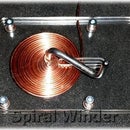Introduction: +/- 0..15V Power Supply - Part 1
This is part 1 of 2. This is the electronics part and the next installment will deal with the transforme etc. as well as the encasing and front panel.
I know some of you will see this as a complicated circuit, but, as with any circuit, if you slice it up into functional blocks, it will become pretty simple to wrap your head around - read on and I promise that it won't bite you ;)
The circuit makes for a simple, but stable, power supply regulator circuit, which only needs a single potentiometer to adjust the positive rail, the negative rail tracks the positive (but negative going of course),
Step 1: BOM and Tools
Bill of Materials
Resistors (all 0.25W):
- R1 270 Ohm
- R1B Depends on potentiometer value - please see text on schematic
- R2..R5 10k
- R6..R9 22k
- R10 220 Ohm
- R11 120 Ohm
- Pot1 5k Lin potentiometer (but see text on schematic for alternatives)
Capacitors:
- C1, C2 100n
- C3, C5, C6, C8 220n
- C4 10µ
- C7 47µ
Diodes:
- D1..D3 1N400n (4001 to 4007)
- ZD1, ZD2 ZPD3V3 (3.3V Zener diodes, but see text for alternatives)
Integrated Circuits:
- IC1 LM317 (Positive voltage regulator)
- IC2 TL072 (Dual Op-amp)
- IC3 LM337 (Negative voltage regulator)
Further:
- K1, K2 3-way screw terminal blocks (or solder the wires)
- J1 a wire jumper/link (a short piece of solid wire)
- Heatsinks for the voltage regulators, but they'll be discussed in the next installment.
Tools Needed:
- Soldering iron and related paraphernalia
- A pair of side/diagonal/whatever cutters
- Multimeter (DVM)
Not explicitly needed, but still nice to have:
- A pair of flat nose or chain nose pliers
- An oscilloscope (any kind really)
- An ample supply of Scotch & Coke - 18+ only ;)
The reason for this
Working with op-amps, a +/- supply is nice (sometimes even needed) to have and a variable supply allows you to e.g. verify the function of a circuit at lower voltage limits, or to run at logic voltages when interfacing such, while still being able to crank it up to a total of 30V rail voltage (+/-15V). Even if you just need a single supply, this will do up to 15V and 1A, however, this is not to be considered a lab supply, as it has got no variable current limiting, but that does not detract from its usefulness, as current limiting is a "Nice to have" thing, that will allow you to have "stupid moments" at the wrong time ;)
If you would rather make e.g. a 30V/10A (or whatever) supply with bells and whistles, please go somewhere else for now, but I rarely need over 15..18V (24..28V on seldom occasions for motors, but who can live with just one supply anyway) and being an electronic engineer with decades of R&D, I am supposed to know what I need :)
Beware though, of false power claims, which seems to infest the entire web (even this site), Just like if I "sold" this supply as being capable of 55.5W, from the fact that the max. voltage/current the LM317/337 can handle is 37V at 1.5A. The 30W it _can_ handle safely (with proper heatsinking), will be enough for most circuits. And a power supply is not really a power supply until it has got power in - so, for the moment (until part 2), this is only an elaborate voltage regulator.
If this (both parts) is well received, I will later post a real lab supply and a practically noiseless (ripple+noise way below 1µV) 9V supply for e.g. guitar pedals, sensitive mike- and instrumentation circuits. Really not trying to sound like a pouting teenager here, but if interest is as low as with the first circuit I posted, it will get more feedback on my web site. Remember, views ain't feedback ;)
Step 2: Discussion of the Circuit
As you can see in the picture above, I have divided the circuit into its functional blocks.
Block A - Power input
The PSU is designed for +/-18V in, but the maximum rating of the supply to the op-amp (a TL072) is +/-18V, so it has to be lowered for a couple of reasons.
First off, you should NEVER run a component at its max. ratings! These ratings are not the manufacturers guarantee, that the component will handle those numbers well, but more of a guarantee, that crossing these limits is a sure way to kill your component (if not immediately, then in a near future).
Second - when you use a mains transformer, its output has to follow the mains voltage, which can vary a bit around the nominal - e.g. the EU harmonizing of mains voltage to 230V a number of years ago, did not really change a thing, because a wide tolerance (+10%/-6%) was incorporated in the bill, as it would have been extremely expensive to actually have the entire EU change all their mains equipment, so the mains voltage in the UK can keep at 240V as always, while the rest of the EU kept to their 220V - all within regulation (wonder how much taxpayer money was poured into passing such a nonsense bill). A 230V nominal transformer will thus have a different (higher) output in theb UK, than the same transformer used in the rest of the EU.
Further, there is voltage variations up/down over a day, depending on the total load, and during weekends, where heavy industry is mostly shut down, the voltage will rise for some consumers. So, always assume the worst case variations and calculate for it.
Hence, you need to supply your op-amp a lower voltage. A quick way of doing this, is to insert zener diodes in the supply lines (the "arrows" marked V+ and V- are the supply pins of the op-amp).
This way of using the zeners does not allow for huge variations and the exact voltage depends a bit on the current drawn by the op-amp, but it saves two resistors (and if there's something I've learned from designing circuits for others to use, it is that most beginners want to shave off whatever is possible - and then some) - if demand arises, I will change it to proper zener regulators). As is, with +/-18V in, the op-amp will get around +/-14.5V to +/-14.8V, which it will handle nicely. If you stock other values of zener diodes in the range ~3V to ~6V you can use those.
Yet a note about the supply voltage: The 18V is the minimum voltage (the valleys of the rectified and filtered voltage - pic 2 above), that the regulators (LM317/LM337) need to stay in regulation at 15V. A 16-0-16V secondary transformer would do this with a sensible amount of (rectification and) filtering.
If you happen to have a transformer a bit lower, the only ill effect will be a lower maximum voltage, where the regulators keeps their output regulated fully and if you have one with a slightly higher voltage, higher voltage value zener diodes can be used, but this is really outside the scope of this instructable and will be dealt with in part two.
Block B - The positive regulator
The positive regulator, an LM317 in an almost bog standard configuration, where the only difference, from common use, is how the lower "adjust" resistor is connected.
Everyone considering electronics as either a hobby or something more serious, should stock a handful of LM317's at all time. Using the ubiquitous 78-family of regulators and having a usable stock, means that you need a lot, e.g. 7805, 7806, 7808, 7809, 7812, 7815, 7818, 7824 (and possibly a few more - and that's just the positive voltage regulators). A single LM317 (LM337 for the 79-family of negative regulators) can replace them all, as it just needs 2 "programming" resistors to give anything from 1.25V to ~35V. In short, the bread & butter of on-board power regulators - and the power supply is the foundation which all electronics circuits have to rely on (whether mains- or battery powered), so if you want to ace out in electronics, start learning the ins and outs of power supplies of _all_ kind.
Block C - The "Ground" reference for the LM317
Usually, you just connect the bottom resistor (the potentiometer here) to ground and the regulator will bottom out at 1.25V. For a lot of research, it is mandatory to be able to get lower than that, so you need a negative reference of exactly minus (-) 1.25V.
That said, the 1.25V is rarely 1.25V, but can be anything from 1.20V to 1.30V, depending on both manufacturing tolerances, adjust pin current and current draw from the output, so making a 1.25000V reference will not quite cut it. In this circuit,
I have designed a circuit that uses an op-amp to constantly monitor the instantaneous adjust voltage and then generate its negative mirror image for the reference - that way the adjust voltage can be all over its tolerance range and still maintain a rock stable lower reference voltage.
C5, by the way, is the output capacitor of the LM317 and should be placed close to the output pin of same. The reason that it is drawn a bit longer downstream is simply to make the schematic as clear as possible.
Block D - Tracking control of the negative regulator
IC2B, the other half of the dual op-amp, maintains the balanced voltage output, by comparing the midpoint of the +/- rails to ground. The reason for using R8 and R9, as opposed to a single 11k resistor (the parallel value of the two 22k's), is simply to make it easier for people stocking just the E12-row of resistor values, feel free to use a single 11k if you have it.
Block E - The negative regulator
The negative regulator, the LM337, is controlled from op-amp IC2B, to mirror the positive output. The adjust pin is filtered with C7, which makes D3 needed, to protect the LM337 from fatal injuries, in case the power input is turned off.
Step 3: Component Overlay and PCB
As you can see, it's very easy to build, when you make the PCB for it.
In case you do want to make a PCB, use the one on the last page of the attached .pdf-file and print it to scale (it is made in size 1:1). The text on the PCB must be readable from the solder side, so if you print it on a LASER printer, the toner side should be towards the copper -this works whether you use photo transfer or a clothes iron on a glossy magazine.
See, that was not as bad as your first look at the schematic made you think... Or what?
Need something clarified? Ned some smaller changes to the circuit? I'll do my best to help you out, but after being ill for a very long time, I just need a week of vacation to get totally into shape (I hope ;), so I'll be answering whatever questions or comments after the 16th. this month.
Next (and final) installment will be about feeding the beast and capturing it in a box with a front panel. Hope to see you back then :)
Attachments

Participated in the
Power Supply Contest

Participated in the
Invention Challenge 2017














